Menus
- New generation
- 4 cylinders in line ShiftCam, 999 cm3, 207 hp, 122 Nm, 197 kg full made, from € 19,200
- Discovery
- In the saddle
- On track
- Braking
- Cycle part
- Comfort
- Conclusion
New generation
4 cylinders in line ShiftCam, 999 cm3, 207 hp, 122 Nm, 197 kg full made, from € 19,200
10 years ! It’s been ten years since BMW revolutionized the superbike segment with its S1000RR, setting new standards for in-line four cylinders in 2009.. The new sports car presented at the last EICMA show in Milan is just as innovative, but in a more subtle way. Call it evolution, not revolution.
 BMW S1000RR review
BMW S1000RR review
Discovery
The objectives set for engineers in 2015 by management when development began was to keep less than 5% of the 8,200 components of the motorcycle, including the engine, to design a brand new machine! In general, the goal was to save one second per lap and make the bike easier to ride, in particular by reducing the weight by 10 kg..
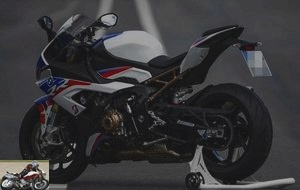 BMW S1000RR
BMW S1000RR
To do this, it was necessary to develop a lighter, more compact and more powerful 999 cm3 engine, while retaining its dimensions of 80 x 49.7 mm. Power nevertheless increased by 8 horsepower to reach 207 hp at 13,500 rpm as well as torque reaching 113 Nm at 11,000 rpm. This engine is not only 12mm narrower than its predecessor, but it also weighs 4kg less, thanks in part to the lighter 1.8kg crankshaft and connecting rods that are 4mm shorter and lighter by 10%, thus offering better efficiency over the entire rev range.
 The engine now delivers 207 horsepower
The engine now delivers 207 horsepower
The most important development, however, was the application of Shiftcam technology, already introduced on the Boxer engine of the R1250GS trail that we tested last year, adapted for the first time to a BMW four-cylinder. This system combines variable valve timing and differential valve lift with revised cam profiles and modified timing to achieve at least 100 Nm of torque from 5,500 rpm and up to the breaker at 14,600 rpm. Note also that this weight loss of 4 kg was made despite the additional kilo necessary for the installation of the ShiftCam.
 BMW S1000RR ride-by-wire accelerator
BMW S1000RR ride-by-wire accelerator
Reducing the weight of the 4-cylinder also goes through the use of 33.5mm titanium intake valves, while retaining steel for the 27.2mm exhaust pipes. Already weighing nearly half the weight of steel, the titanium valve shafts have been hollowed out to further reduce the weight by 10%. This Formula 1-derived technology is accompanied by DLC-coated rocker arms, smaller and 25% lighter, which have increased engine speed by 400 rpm and peak power while maintaining a compression ratio of 13, 3: 1. The chain drive of the two overhead camshafts is now done directly by the crankshaft.
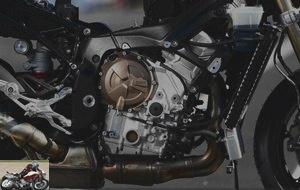 The 4 cylinder ShiftCam of the BMW S1000RR
The 4 cylinder ShiftCam of the BMW S1000RR
The overhaul of the intake ducts of the 16-valve DOHC engine as well as the new 1.3 kg stainless steel exhaust system, with two three-way catalysts, two lambda sensors and an electronic power regulator, contribute to the new performance. increases in the motorcycle, even while remaining compliant with Euro4. And as before, the new RR engine is also fitted with a variable-length intake system, with the length of the intake horns above the 48mm throttle bodies being shortened thanks to an electric motor at 9,500 rpm. to improve performance with the ShiftCam.
 BMW S1000RR laid bare
BMW S1000RR laid bare
In addition, the actuation of the four butterflies is done distinctly between the two left and two right butterflies. This allowed BMW engineers to program the two pairs to work differently at low revs to deliver the traction advantages of a twin-cylinder engine, before the four reworked in unison to more. high speed. This characteristic stems from the fact that BMW decided not to produce a Yamaha YZF-R1 type crossplane engine, but rather to use its experience of a more traditional 180 ° screamer engine..
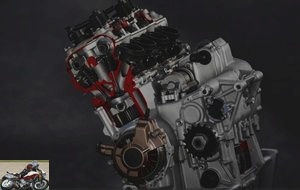 BMW S1000RR engine cut
BMW S1000RR engine cut
The resulting all-new engine powers what is now a much lighter motorcycle with 197 kg all full, including the 16.5-liter fuel tank, compared to 208 kg for the outgoing model, which is 11 kg less than ‘previously, with a front / rear weight distribution of 53.8 / 46.2% vs. 52.3 / 47.7% previously, providing better grip from the front.
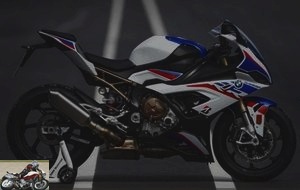 The wheelbase is 9mm longer
The wheelbase is 9mm longer
The major exterior change is the abandonment of the old asymmetrical headlights of the S1000RR, while retaining this recognizable silhouette with now fully LED lighting. But below that, the all-new 1.3kg double-spar frame, which is lighter and made of four cast and welded aluminum pieces, uses the 32 ° forward-tilted motor as a load bearing element..
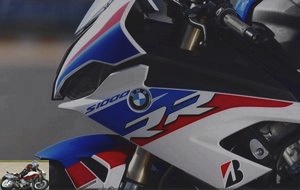 The fairing of the BMW S1000RR
The fairing of the BMW S1000RR
In search of excellence for this uncompromising machine, BMW changed supplier for the chassis equipment. Marzocchi replaced Ohlins for the suspensions, Continental was chosen over Bosch for the ABS system and, perhaps even more surprisingly, the American brake specialist Hayes was preferred to Brembo for the 4-piston radial calipers that bite into 320mm floating discs via a Nissin radial master cylinder. The discs are still Brembo made, as is the rear caliper and its 220 mm disc..
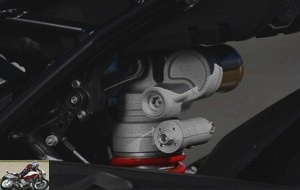 BMW S1000RR rear shock absorber
BMW S1000RR rear shock absorber
And the version equipped with the M Pack sparkles even more under its Motorsport wrapping with a weight that even drops to 193.5 kg thanks in particular to carbon rims, a lighter lithium-ion battery, a sport saddle and an M chassis kit. -Series with swing arm pivot adjustable in height. Racing Red is therefore the only color available for the standard version of the 2019 S1000RR, which may seem strange.
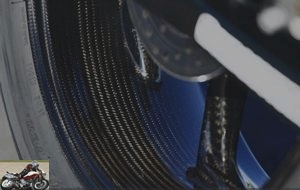 The M pack includes carbon rims
The M pack includes carbon rims
In the saddle
A whole group of S1000RR M’s were waiting for our test group when the bike was launched on the Estoril Grand Prix circuit, the 4.8 km of which were recently resurfaced. This is an event that I was looking forward to, especially after having driven the fabulous HP4 Race there two years ago..
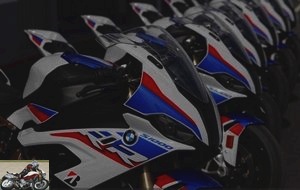 BMW S1000RR ready to hit the track
BMW S1000RR ready to hit the track
One of the reasons there are so many golf courses in Portugal is that it rains a lot outside of the summer. Obviously, it was a deluge that came crashing down on us for this early spring test, leaving wet marks on this new difficult-to-read asphalt that disrupted my first 20-minute session before the rain redoubled. These conditions prevented us from pushing the bike to its limits and measuring the contribution of the radical chassis of the new BMW, even if we were able to test the effectiveness of the Rain version of one of the four driving modes offered by the new Bosch ECU (Road, Dynamic, Race, plus three optional configurable Pro modes).
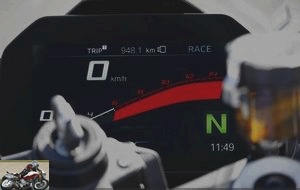 BMW S1000RR TFT screen
BMW S1000RR TFT screen
On the other hand, I was able to feel the advantages of the new chassis design which, as soon as you get in the saddle, is much narrower behind the tank. So although the seat height of 824mm is actually higher than that of the old S1000RR, it feels like it’s lower, this is also due to the fact that the tank is made up of three sections. aluminum noticeably narrower at the rear. You feel much closer to the bike and less perched on it, as was the case on the old one. The new chassis is also 13 to 30mm narrower between the thighs.
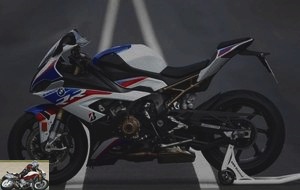 The 2019 BMW S1000RR
The 2019 BMW S1000RR
The handlebar position is also different: it’s wider and the straps are slightly lower than before, although the rider sits the same distance from both wheels on the 1,441mm wheelbase that’s 9mm longer. However, we do not feel as much the weight on his wrists and shoulders, as was the case on the old one. This bike is probably better suited to long runs, especially with its riding position which offers more space. This new more flexible chassis is undoubtedly one of the reasons why the bike is more responsive and offers better feedback from the front axle..
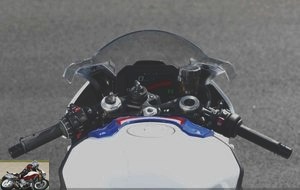 Ergonomics of the BMW S1000RR
Ergonomics of the BMW S1000RR
On track
This reinforced feeling of being at one with the bike definitely boosts confidence once on the track and in that sense the wet conditions I had to face were a good test for the handling of the BMW..
 BMW S1000RR review at Estoril
BMW S1000RR review at Estoril
The electronically adjustable 45mm Marzocchi inverted fork with 120mm travel has a 23.1 ° castor angle with 93.5mm drag, despite all this fairly aggressive geometry is very stable when the TFT screen is displayed. was posting 276 km / h in the long, long straight Estoril, after passing last gear at the start line.
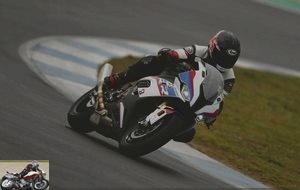 We had to deal with the rain during this test
We had to deal with the rain during this test
After downshifting up to second gear without touching the clutch lever thanks to the well calibrated Shift Assistant Pro shifter installed as standard for downshifting, the front Bridgestone tire gave me good feedback as I m ” entered the first right turn, cautiously at first and then with growing confidence realizing how much grip this front rain tire offers and how well the Marzocchi fork cushions well with its new generation of electronic DDC tuning.
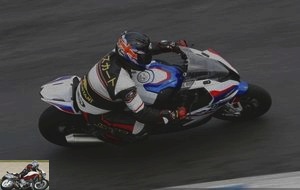 The BMW S1000RR at acceleration
The BMW S1000RR at acceleration
Oh, and the Continental ABS triggered well as expected in the rain. It almost feels like a super pilot, even if I don’t drive like one, but in the rain, we appreciate the range of electronic driving aids of the new RR all the more..
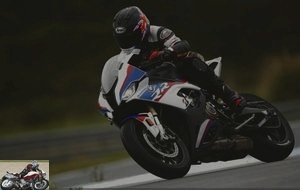 The BMW S1000RR on the Estoril track
The BMW S1000RR on the Estoril track
The qualities of this new engine were felt even more between showers, especially during the first session before it started to rain again, when I found a few dry sections to use Road and Dynamic modes on. The engine revs up noticeably faster than before, which wasn’t really slow, but had more inertia on acceleration. BMW engineers have managed to harness that extra twist, not only with more user-friendly than intimidating throttle response, but also with more flexibility. The ride by wire sends smoothly 4,000 rpm to the switch, without the slightest jerk when power comes in, not even when the variable intake system sees the intake horns lift up from the throttle bodies . Knowing very well when this was going to happen, I was careful, but I could not detect it and it is the same for the milliseconds necessary for the transition of the cams, almost undetectable. It works ! The same goes for the electronic throttle which offers full control of the throttle opening, especially in these wet conditions..
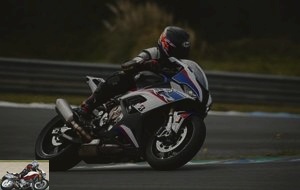 The S1000RR demonstrates great maneuverability
The S1000RR demonstrates great maneuverability
The acceleration of the new S1000RR is truly impressive, but I can’t say that I saw how much the rear tire grips when cornering on a dry track, other than the Rain Mode traction control settings. performed very well, as evidenced by the way the orange light on the dashboard flashed for about 90% of a wet lap in Estoril, including at high speed in the straight line of the circuit. I should just ask the question and try to get another spin this summer on what really is a step forward in Superbike design..
Braking
With all the electronic aids, it makes it harder to gauge the full difference between Hayes and Brembo calipers, although I found the latter less fierce when starting the brakes. It must be said that both the engine brake provided by the Rain mode and the anti-dribble clutch help to support the Hayes / Brembo / Nissin front brake set to brake the bike at high speed..
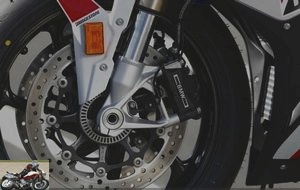 The Hayes front calipers of the BMW S1000RR
The Hayes front calipers of the BMW S1000RR
Cycle part
Thoroughly reviewed, the cycle part of the S1000RR worked wonderfully on this Estoril track, even wet. The S1000RR is very agile, thanks in particular to a less gyroscopic effect and well helped by the carbon fiber rims of the M version that I was driving. The Bridgestone front tire gives good feedback and works in concert with the electronically adjustable Marzocchi fork, all of which is perfectly supported by the multiple assists. Same thing at high speed where stability is not lacking.
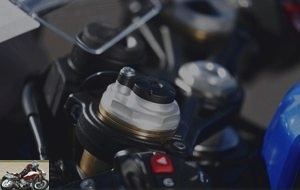 The Marzocchi inverted fork of the BMW S1000RR
The Marzocchi inverted fork of the BMW S1000RR
Comfort
More compact and lighter, the S1000RR is surprisingly more comfortable with its narrower seat base, allowing more range of motion and a less painful riding position on the wrists. Of course, this notion of comfort is quite relative. We’re still talking about a superbike, not a touring machine.
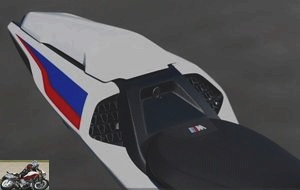 BMW S1000RR seat
BMW S1000RR seat
Conclusion
Electronic programs accessible and easy to use! What sums up the new BMW S1000 RR. In addition, this production superbike includes many neat parts like the one-piece swingarm in cast aluminum or the heel guards of the footpegs made from recycled carbon fibers, not to mention this tank welded in the BMW plant in Berlin from of three aluminum sections made in Italy.
And when it’s the fastest man in the history of the Tourist Trophy on the Isle of Man (on a BMW of course), Peter Hickman, who tells you that this new bike takes a significant step forward compared to the old one, one would almost believe it.
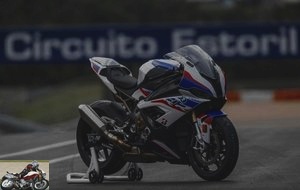 The BMW S1000RR on the Estoril circuit
The BMW S1000RR on the Estoril circuit
However, deliveries will not begin before June for a price starting at 19,200 euros and to which we will have to add 3,530 euros for the M pack. The manufacturer’s objective is to produce 6,000 of its S1000RR this year in its plant in Berlin and there is already a long waiting list despite this late arrival on the market.
Faced with the BMW S1000RR, several European competitors have recently been renewed, starting with the Ducati Panigale V4 available from 22,790 euros or the Aprilia RSV4 1100 Factory priced at 22,999 euros. Among the Japanese, we find the indestructible Honda CBR1000RR Fireblade (17,999 euros), Kawasaki Ninja ZX-10R (18,099 euros), Suzuki GSX-R 1000 (16,599 euros) and Yamaha YZF-R1 (18,999 euros).
Strong points
- Motor
- Dynamic efficiency
- Agility and stability
- Convincing assistance
- General ease
Weak points
- Option prices
- Motorsport colors reserved for the M pack
The technical sheet of the BMW S 1000RR
Related articles
-
Cargo Flat twin, 1254 cm3, 136 hp, 143 Nm, 243 kg all full facts, 15,350 euros. Old tradition as the RS model at BMW, until the previous R 1200 RS. The…
-
Suzuki GSX-R 600 motorcycle test
Little Queen Revamped this year, the 600 GSXR follows in the footsteps of its big sister 750 cm3 from which it borrows the dress and even all the…
-
Indian 1200 FTR Rally motorcycle test
Bite V-Twin, 1203 cm3, 120 hp, 120 Nm at 6,000 rpm, 235 kg TPF, 14,990 euros … daily test The word scrambler warms up lots of images, broadcast, told,…
-
Honda CBR1000RR-R Fireblade SP motorcycle test
The meaning of paradox or how to abandon Total Control for Total Taule 4 cylinders in line, 999 cm3, 217hp, 113 Nm, 201 kg all full facts, 24,999 euros…
-
Ducati Panigale V2 motorcycle test
Mini-V4, maxi-pleasure? Controlled origin flavor V-twin Superquadro 955 cm3, Euro5, 155 hp and 104 Nm, 176 kg dry, 18,290 euros Family culture obliges,…
-
Kawasaki Z1B Moriwaki motorcycle test
Wild and brilliant roadster 4 cylinders in line, 1,135 cm3, 119 hp, 160 kg It has been exactly 40 years since New Zealander Graeme Crosby entered the GP…
-
Small (Force of) strike ! Unchanged since 2010, the Yamaha R6 remains a benchmark in the Supersports segment. Light and radical, it is as pleasant on the…
-
Track test: An R1 or Nothing ? Queen of beauty, the R1 has won over many bikers with its plastic and dynamic qualities. In 14 years of existence it has…
-
French watch or Gallic genius ? 128 hp Honda Moto2 engine, parallelogram suspension front axle, adjustable geometry, solid 7075 T6 aluminum chassis, 154…
-
MV Agusta Superveloce 800 motorcycle test
Neo-retro in the right tempo 3 cylinders of 798 cm3, 148 hp, 88 Nm, 173 kg, 20,300 euros Concept bike adapted in an ultra exclusive limited series, the…